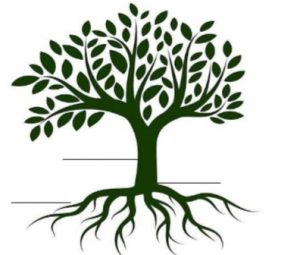Some of the most three complicated morphological terms are: root, base and stem
Look at these three words. They are familiar, right? These are words associated with a tree. So, our knowledge of the words will also be viewed from the point of a tree. First off, the three terms work together.
Look at the diagram below before we proceed to explanations.

For the tree, the root is that part sunk deep into the earth. When a seed is planted, it starts growing from the ground, from the root. So, is the root of the word. It is that part of the word that brings about different forms. It is the part that serves as the foundation to the whole word, the pillar every other thing stands on. The word starts growing from the root.
By definition, the root is that part of the word that remains when every other part is removed because it carries the core meaning of the word. The root is the free morpheme of the word. Look at the word UNFAITHFULNESS. The first word you will have is FAITH. It is this word that you begin to modify to have other words. Clear, right? Look at UNSATISFACTORILY for example. You first have satisfy. Then, satisfactory. Then, satisfactorily. Then, UNSATISFACTORILY.
The base is the level ground that a tree can grow on. So, the base is that part that can accept the growth of any tree. Therefore, the base, by definition, is that part of the word to which any affix can be added. For example, in the word UNFORTUNATELY, we have UN-FORTUNE-ATE+LY. FORTUNE is the root. It is also the base for FORTUNATE and FORTUNATE is the base of FORTUNATELY because it can accept an affix or modification and FORTUNATELY is the base to UNFORTUNATELY. that’s simple enough to grasp, I believe.
Look at the tree and how it builds up. The branches are the last to be added, right? If you cut these branches off, the tree would still be what it is. This is because the branches don’t have much meaning. They are inflections of the tree. The stem is the whole tree. So is the stem of the word. It is the word in the last stage before an inflectional affix is added. The STEM is that part to which the last affix is added and this is usually an inflectional affix. For example, the word DRIVERS. DRIVE is the root and adding ER derives a new word but adding S to the word does not derive something new. You see DRIVER being the part that the last inflectional affix is added? That’s the stem.
In summary,
- The root is the first part of the word
- The base is the part of the word that can accept any affix
- The stem is the part to which the last affix is added and the affix is usually inflectional.
- A root can be a base and a stem.
- All roots are bases but not all bases are roots.
- All stems are bases but not all bases are stems.
- Thanks for reading. 😎😎😎
Thank you very. Much. You are Soo great, everything is on point and you clear everything for me. Wish to meet you one day
Thank you, Richmond.
Thank you for making it so simple. I flipped pages of Morphology textbooks to understand this simple difference between them and my professor wasn’t of much help either. You saved my test which will be taken tomorrow.
Thanks again!
I hope your results were great. Thanks for checking in.
Can you give us examples to illustrate the last claims.
roots can be bases but bases can’t be roots.
Bases can be stems but stems can’t be bases.
Thanks
Thank you for the excellent explanation!
You’re welcome. I’m glad it helped.
It’s an apt illustration (with a tree diagram) as the terminology is adopted from botany/natural science
Thank you for your kind words.
Thank you so much🙏
This is very practical and explanatory. Thank you sir.
You’re welcome, Grace. Please, do well to check out other articles from us.